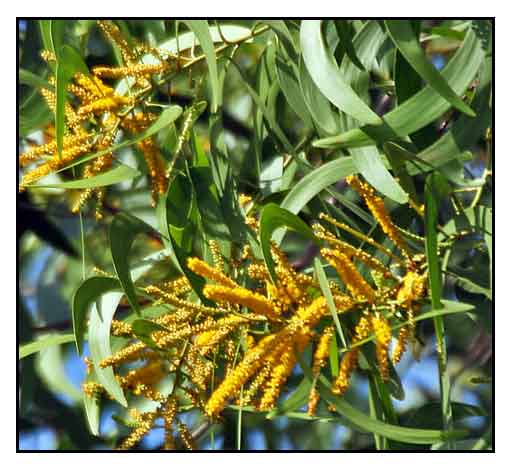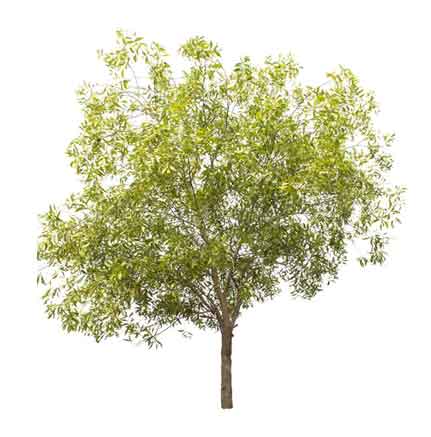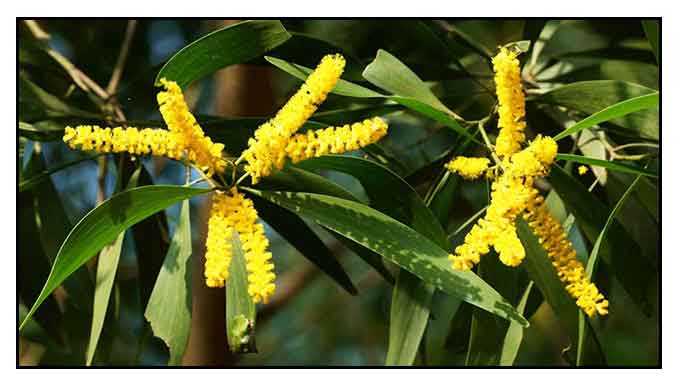 Gen info Gen info
- The genus Acacia comprises about 1,200 species, belonging to the family Leguminosae, the third largest family of flowering plants. It is a large genus with about 900 species, approximately 700 of which are native to Australia. (8)
- Genus name acacia comes from the Greek word "akis" meaning a sharp point, referring to the thorns of the plant. The specific epithet derives from the Lain "auricula", meaning external ear of animals, and "forma" meaning form or shape, alluding to the shape of the pod. (3)
- In Australia, the whole genus of Acacia is applied the name "Wattle".
- It has about 47,000 seeds per kilogram (21,000/lb). (3)
Botany
Acacia auriculiformis is an evergreen, unarmed tree growing up to 15 meter high, the trunk up to 12 meters long and 50 centimeters in diameter. Branchlets are angular and glabrous. Bark is gray or brown, smooth in young trees, rough and vertically fissured  with age. Foliage is dense, with an open and spreading crown. Leaves are alternate, simple, reduced to phyllodes (flattened leaf stalks), blade-like, slightly curved, 11 to 20 centimeters long, dark green surfaces, with 3 to 7 main parallel veins, with a marginal gland near the base. Branchlets are flattened and curved, appearing like leaves joined by twisted, brown, ear-shaped seed pods. Flowers are 5-merous, bisexual, tiny, sessile, and fragrant, in loose, yellow-orange spikes at the leaf axils, or in clusters of spikes at stem tips. Fruit is a flat, dehiscent pod, about 6.5 centimeters by 1.5 centimeters wide, cartilaginous or woody, brown, glaucous, transversely veined with undulate margins, twisted on maturity with irregular spirals. Seed is broadly ovate to elliptical, 4 to 6 millimeters by 3 to 4 millimeters, shiny, black and hard. (2) (8) with age. Foliage is dense, with an open and spreading crown. Leaves are alternate, simple, reduced to phyllodes (flattened leaf stalks), blade-like, slightly curved, 11 to 20 centimeters long, dark green surfaces, with 3 to 7 main parallel veins, with a marginal gland near the base. Branchlets are flattened and curved, appearing like leaves joined by twisted, brown, ear-shaped seed pods. Flowers are 5-merous, bisexual, tiny, sessile, and fragrant, in loose, yellow-orange spikes at the leaf axils, or in clusters of spikes at stem tips. Fruit is a flat, dehiscent pod, about 6.5 centimeters by 1.5 centimeters wide, cartilaginous or woody, brown, glaucous, transversely veined with undulate margins, twisted on maturity with irregular spirals. Seed is broadly ovate to elliptical, 4 to 6 millimeters by 3 to 4 millimeters, shiny, black and hard. (2) (8)
Distribution
- Introduced, naturalized.
- Native to Maluku, New Guinea, Northern Territory, Queensland.
- Natural strands found Papua New Guinea and Indonesia.
- Widely planted in tropical Asia, with extensive plantings in China and India.
- Commonly riparian ie ringing perennial rivers and semi-perennial creeks; forms discontinuous populations along drainage systems.
Occurs from near sea level to 400 m. (24)
- In some countries, considered an invasive species.
 Constituents Constituents
- Phytochemical analysis of various leaf extracts yielded alkaloids, flavonoids, steroids, tannins, glycosides, and saponins. (see study below) (6)
- Study isolated a new triterpenoidal saponin from an aqueous EtOH extract of legumes of Acacia auriculiformis characterized as 3-O-{[ß-D-xylopyranosyl{1-->3)-ß-D-xylopyranosyl(1-->4)-a-L-rhamnopyranosyl (1-->2)-[a-L-rhamnopyranosyl(1-->4)]-ß-D-glucopyranosyl)-3,16,21-trihyydroxyolean-12-en-28-oic acid.
(15)
- Phytochemical screening for secondary metabolites yielded reducing sugars, steroids, triterpenoids, anthraquinone, phenols, tannins, saponins, and leucoanthocyanins.
(16)
- A methanol extract of leaves yielded saponins, tannins, alkaloids, flavonoids, steroids, and phenolics. (see study below)
(18)
- Study of heartwood of A. auriculiformis for bioactive compounds isolated two methylated teracacidins and chalcone-like teracacidin, along with three known compounds. (see study below) (32)
 Properties Properties
- Drought tolerant.
- Studies have shown antibacterial, antifungal, antioxidant, anti-inflammatory, mosquito larvicidal, antimalarial, wound healing, spermicidal, learning and memory enhancing, antidiabetic, weak aphrodisiac, anti-arthrtic properties.
Parts used
Bark, pods, leaves, oil.
 Uses Uses
Folkloric
- No reported folkloric medicinal use in the Philippines.
- Bark used for pain and inflammation; also used for treatment of cancer.
- Root extracts used for treatment of aches and pains, and sore eyes.
- In Australia, aboriginal people rub the lather obtained from pods on to soothe itchy skin.
(22) Bark extract used to treat rheumatism. (5)
- In Central Africa, a folk remedy for diabetes. (26)
Others
- Wood: Sapwood is yellow; heartwood light-brown to dark red, durable. Excellent for turnery articles, toys, carom coins, chessmen, and handicrafts. Also used for making furniture and tools, joinery. (3)
-
Ornamental: An excellent shade tree. Attractive wayside tree with its bright yellow flowers. In Myanmar, flowers are marketed as altar flowers. (2)
-
Fuelwood: A major source of firewood; makes good charcoal. Dense with high energy value. (2) It provides high calorific value of 4800 to 4900 kcal/kg. It burns without smoke and sparks. (20)
-
Agroforestry: Its superficial and densely matted root system makes it suitable for stabilizing eroded land. Used for revegetation and rehabilitation of degraded land in Indonesia. (2)
-
Construction: Wood extensively used for paper pulp and small saw timber. Used as wattle: poles for house building. Used for veneer and furniture making. (2)
- Pulp: Wood is good for making pulp of high strength properties suitable for the paper and pulp industry. (20)
-
Tannin / Dye: Bark yields sufficient tannin (13-25%) for commercial exploitation and contains 6-14% of a natural dye suitable for the soga-batik industry. (3)
- Fodder: Not widely used as fodder, but in India, cattle browse on year-old plantations. (3)
- Gum: Tree yields a gum that is sold commercially, but not as useful as gum arabic. (3)
- Apiculture: Flowers a source of pollen for honey production. (3)
-
Biogas: Leaves has potential for production of biogas because they are easily degradable. (20)
Studies
• Effect on Learning and Memory / Leaves: Study evaluated the effect of ethanolic extract of Acacia auriculiformis leaves on learning and memory in rats. The extract produced dose-dependent improvement in memory score in step through latency in passive avoidance model (p<0.001) and percentage of correct responses in rewarded alternation test (p<0.05). There was also dose-dependent inhibition of brain cholinesterase activity (p<0.001). The acetylcholinesterase inhibiting property contributes to its memory enhancing potential. Results suggest new option for treatment of dementia and other cognitive deficits. (5)
• Anti-Inflammatory / Antioxidant / Leaves: Study evaluated the in vivo anti-inflammatory potential of various extracts of leaves of A. auriculiformis using carrageenan and formalin induced inflammation in rats. Butanol and methanol leaf extracts showed significant antioxidant free radical scavenging activity using DPPH, hydrogen peroxide scavenging and reducing power assay. Methanol and petroleum ether extracts at dose of 400 mg/kg showed highest percentage inhibition of 84.88 and 82.12, respectively in the carrageenan model. Activities observed were attributed to to sterols and phenolic compounds. (see constituents above) (6)
• Wound Healing / Bark: Study evaluated the in-vivo wound healing activity of an ointment containing 5% w/w ethanol and aqueous bark extracts of A. auriculiformis using wound models in Swiss albino mice. Results showed both formulations possessed significant wound healing activity, evidenced by decreased period of epithelization, increased rate of wound contraction, tensile strength, hydroxyproline content, granulation tissue and collagen fiber formation. Activity was attributed to phenols, tannins, and flavonoids. The ethanol extract ointment showed better wound healing activity. (7)
• Entomotoxicity / Insecticidal / Oil: Study evaluated the insecticidal efficacy of Acacia auriculiformis oil extract against infestation of Callosobruchus on cowpea seed. Results showed only 5% concentration of the oil achieved more than 50% mortality of the insect at 96 h post treatment. The 5% concentration recorded lowest oviposition, adult emergence, seed damage, weight loss. The high insecticidal potential suggests the oil can be integrated into pest management technology. (9)
• Antimalarial / Leaves: Study evaluated the in vivo antiplasmodial activity of ethanol leaf extract of Acacia auriculiformis in Plasmodium berghei infected mice. Results showed extract dose of 350-1050 mg/k/day exhibited significant (p<0.05) blood schizonticidal activity both in 4-day early infection and in established infection. The mean survival time was not comparable to that of standard drug, chloroquine 5mg/kg/day. The antiplasmodial activity of the leaf extract confirms its use in folkloric medicine treatment of malaria. (10)
• Mosquito Larvicidal / Antioxidant: Study evaluated solvent extracts of A. auriculiformis for antimicrobial, antioxidant, and larvicidal properties against malarial and Japanese encephalitis vector Aedes albopictus and Culex quinquefasciatus, respectively. Ethanol, ethyl acetate, and water extracts significantly inhibited the test pathogens. The ethanol and chloroform extracts showed strong antioxidant activity on DPPH and FRAP. The ethanol extract significantly inhibited the mosquito vectors with LC50 of 6.1 and 4.2 µg/ml, respectively. Results suggest a potential eco-friendly and biodegradable source of larvicides against two important mosquito vectors with low toxicity against non-target vectors. (11)
• Acaciaside-B / Intravaginal Spermicide / Seeds: Study identified a triterpene glycoside, Acaciaside-B (Ac-B)--enriched fraction (Ac-B-en) from seeds of A. auriculiformis and evaluated it for spermicidal potential in vitro. Results showed completely inhibition of sperm motility within 20s at a minimum effective concentration (MEC) of 120 µg/ml. The spermicidal effect was associated with with loss of sperm plasma membrane integrity and dissolution of acrosomal vesicle. Results showed significant spermicidal potential with no possible mutagenic effect and adverse impact on lactobacilli growth and suggest potential for the development of a safe and effective intravaginal contraceptive formulation. (12)
• Antibacterial / Antifungal / Leaves: Study evaluated the in vitro antimicrobial properties of aqueous and ethanol leaf extract of A. auriculiformis against gram-positive cocci, gram-negative bacilli, MDR gram-negative bacilli, and fungus. Results showed the ethanolic extract exhibited antibacterial activity against all strains including MDR strains of K. pneumonia and E. coli. Both leaf extracts exhibited antifungal activity against Candida albicans. (13)
• Silver Nanoparticles / Antifungal / Bark: Study reports on the green eco-friendly synthesis of silver nanoparticles using crude bark extracts of A. auriculiformis (14)
• Anticholinesterase / α-Glucosidase Inhibitory / Antioxidant / Leaves: Study evaluated the in-vitro anticholinesterase, α-glucosidase and antioxidant activities of α-spinasterol isolated from Acacia auriculiformis leaves. Spinasterol exhibited moderate anticholinesterase activity (OC50 44.19 µg/mL, significantly different from standard galanthamine (IC50 1.73 µg/mL). It also showed good α-glucosidase inhibitory activity with IC50 8.65 µg/mL, not significantly different from standard acarbose (IC50 2.79 µg/mL). The compound showed weak free radical scavenging activity. Results suggest potential in the search for drugs against Alzheimer disease and diabetes mellitus. (17)
• Antifungal / Leaves: Study evaluated the potential of a leaf extract of A. auriculiformis as antifungal against Candida albicans. Results showed the leaf extract at concentrations of 1%, 5%, and 10% have potential as antifungal against C. albicans growth. (see constituents above) (18)
• Tetrahydroxy Flavone / Protein Kinase Inhibitory Activity / Potential Anticancer / Bark: Study evaluated extract and fractions of Acacia auriculiformis for protein kinase inhibitory activity. The ethyl acetate and n-butanol soluble fractions and compound 1 inhibited all the protein kinases tested. The EA fraction showed highest activity against Haspine kinase with IC50 of 1.0 µg/mL. From the EA fraction, the compound 2,4',7,8-tetrahydroxy flavone was isolated. The compound was shown to be a DYRK1A and CDK9 inhibitor which suggests an anticancer potential for the plant. (19)
• Cestocidal / Funicles: Study evaluated the cestocidal activity of A. auriculiformis ethanol extract and saponins from funicles in rats harboring a single adult worm of Hymenolepis diminuta. Adult worms were expelled within 5 days of the ethanol extract and within 3 days of saponin treatment. There were o side effects observed in the treated rats. (21)
• As Natural Food Preservative: Study evaluated A. auriculiformis, A. leptoloba, and A. disparrima against a panel of food spoilage and food poisoning bacteria. Growth inhibitory activity was quantified by MICs ,and toxicity by Artemia franciscana nauplii bioassay. The lack of toxicity of the Acacia sp. leaf extracts and their growth inhibitory bioactivity against the panel of test bacteria indicate their potential in the development of natural food preservatives. (23)
• Antidiabetic / Antioxidant / Leaves : Study evaluated the antioxidant and enzyme inhibitory potential of hydroethanolic leaf extract (HEAA) and its fractions at concentrations of 100-500 µg/mL. The leaf extract and ethyl acetate fraction showed maximum scavenging effect (60.43 and 50.87) at 500 µg/ml, respectively. In enzyme inhibition assays, the HEAA and ethyl acetate fraction showed maximum inhibition against α-amylase (61.69 and 53.87), α-glucosidase (63.34 and 58.46), and pancreatic lipase (51.77 and 49.87), respectively, at 500 µg/ml, with significant IC50s. Results suggest the HEAA possesses good antioxidant and enzyme inhibitory potential, which may be responsible for its antidiabetic effect. (25)
• Pesticidal / Bioefficacy against Bactrocera cucurbitae: Synthetic chemical pesticides raise concerns for environmental and human health. Study evaluated the insecticidal potential of purified fractions from A. auriculiformis against selected pest, B. cucurbitae, the melon fruit fly. Results showed the fractions of ethyl acetate extract have promising effect against insect pests, evidenced by significantly reduced emergence, increased mortality, and decreased pupal weight of pest with treatments. Study of active ingredients showed flavonoids make up the majority of the fractions, and mainly apigenin, gallic acid, and catechin in fraction A1, A2, and A4 respectively. Results provide a base for further development of ecofriendly chemicals as potential control agents of insect pests like B. cucurbitae. (26)
• Antidiabetic / Aphrodisiac / Antimicrobial / Stem Bark: Study evaluated the in vitro antidiabetic, aphrodisiac, and antimicrobial properties of parapropoxybenzoic acid isolated from A. auriculiformis stem bark. 4-Propoxybenzoic acid showed weak aphrodisiac property. Extract showed antidiabetic activity with dose-dependent inhibition of α-amylase with IC50 of 50 µg/ml, comparable to standard acarbose. At concentration of 200 µg/mL, the compound exhibited highest zone of inhibition of 18 mm against Vibrio cholerae. Results showed 4-propoxybenzoic acid has good antidiabetic and antimicrobial and weak aphrodisiac properties. (27)
• Anti-Arthritic / Stem Bark: Study evaluated the invitro anti-arthritic activity of ethyl acetate, ethanol and aqueous bark extracts of Acacia auriculiformis. Denaturation was induced by incubating the extracts with bovine albumin under controlled experimental conditions. The plant extracts showed anti-arthritic activity in a concentration dependent manner, with activity increasing with increased concentrations. Ethanol extract was more effective than other extracts. Activity may be due to presence of phenols, tannins, and flavonoids. (28)
• Antioxidant / Antiproliferative / Breast Cancer Cell Lines / Leaves: Study evaluated the antioxidant activity, cytotoxic and antiproliferative activity of acacia leaves extract against T47D and MCF-7 breast cancer cell lines. TLC showed the methanol leaves extract contained a phenolic compound with IC50 of 9 ppm indicating high antioxidant activity. MTT assay for cytotoxicity showed IC50 of 273.8 and 31.26 ppm for T47D and MCF-7 cells. Results suggest high antioxidant activity antiproliferative activity against MCF-7 cell line. (29)
• Wound Healing / Cytotoxicity / Leaves: Study evaluated the wound healing efficacy of leaf extracts of A. auriculiformis using antidiabetic invitro assays of α-aglucosidase and α-amylase methods in a streptozotocin-induced diabetes model, measuring period of epithelization, % wound contraction, and hydoxyproline content in an excision wound model. A methanol leaf extract showed highest percentage inhibition of 94.259% and 95.259% in α-glucosidase and α-amylase invitro antidiabetic assays respectively. Cytotoxicity studies using different cell lines (A549, HEK293, and MCF7) showed greater than 75% of cells visible in all cell lines, which confirm the biocapability of the extract. LC-MS/MS study revealed presence of ß-sitosterol, lupeol, stigmasterol, and quercetin. Results suggest potent as complementary and alternative therapy of diabetic wounds and management of oxidative stress and diabetes. (30)
• Potential Biomedicines-Vaccine / Okra Diseases and COVID19: Study reports on A. auriculiformis extract efficacy and potential as a biomedical drug or vaccine against various plant diseases by synthesis of new PR-proteins, increasing natural defense response, and potential for the preparation of a vaccine against COVID19. (31)
• Antioxidant / Teracacidins / Heartwood: Study of heartwood of A. auriculiformis for bioactive compounds isolated two methylated teracacidins and chalcone-like teracacidin, along with three known compounds. The compounds showed good radical scavenging and reduction activity, compared to crude extract and ascorbic acid, using three different antioxidant assays. (32)
Availability
- Wild-crafted.
- Ornamental cultivation.
- Seeds, oil in the cybermarket.
|

![]()



 Gen info
Gen info with age. Foliage is dense, with an open and spreading crown. Leaves are alternate, simple, reduced to phyllodes (flattened leaf stalks), blade-like, slightly curved, 11 to 20 centimeters long, dark green surfaces, with 3 to 7 main parallel veins, with a marginal gland near the base. Branchlets are flattened and curved, appearing like leaves joined by twisted, brown, ear-shaped seed pods. Flowers are 5-merous, bisexual, tiny, sessile, and fragrant, in loose, yellow-orange spikes at the leaf axils, or in clusters of spikes at stem tips. Fruit is a flat, dehiscent pod, about 6.5 centimeters by 1.5 centimeters wide, cartilaginous or woody, brown, glaucous, transversely veined with undulate margins, twisted on maturity with irregular spirals. Seed is broadly ovate to elliptical, 4 to 6 millimeters by 3 to 4 millimeters, shiny, black and hard. (
with age. Foliage is dense, with an open and spreading crown. Leaves are alternate, simple, reduced to phyllodes (flattened leaf stalks), blade-like, slightly curved, 11 to 20 centimeters long, dark green surfaces, with 3 to 7 main parallel veins, with a marginal gland near the base. Branchlets are flattened and curved, appearing like leaves joined by twisted, brown, ear-shaped seed pods. Flowers are 5-merous, bisexual, tiny, sessile, and fragrant, in loose, yellow-orange spikes at the leaf axils, or in clusters of spikes at stem tips. Fruit is a flat, dehiscent pod, about 6.5 centimeters by 1.5 centimeters wide, cartilaginous or woody, brown, glaucous, transversely veined with undulate margins, twisted on maturity with irregular spirals. Seed is broadly ovate to elliptical, 4 to 6 millimeters by 3 to 4 millimeters, shiny, black and hard. ( Constituents
Constituents

